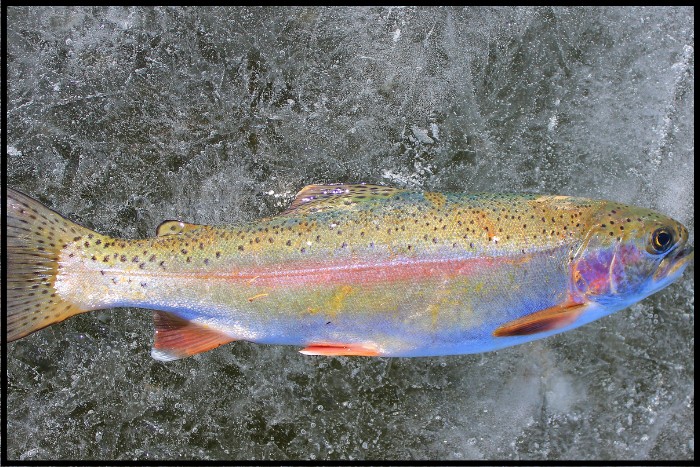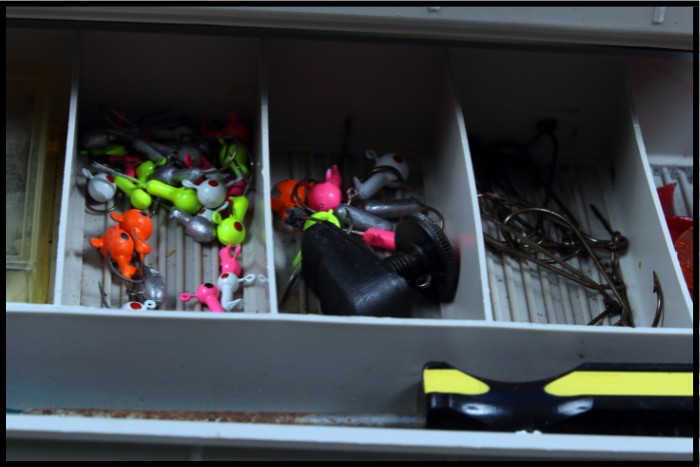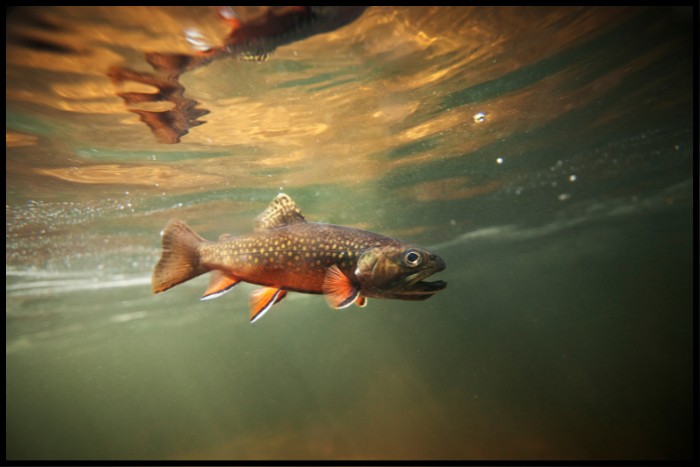There are 14 different species of trout across the world. All have different features and live in different areas, so trout aren’t hard to find as long as the water conditions can support a population.
Rainbow trout are distinct from other trout species due to their vibrant coloration and unique habitats. They thrive in highly oxygenated waters below 65F with abundant insect populations. While they share similarities with other trout, specific features set them apart.
Rainbow trout are beautiful fish well-known for their aggressive behavior and heartiness.
Rainbow Trout Basics
1. Main Features & Appearance
Rainbow trout get their name from their pink and purple stripes across their body’s sides. The rest of their body is a silver color with a plethora of black spots.
Their torpedo-style body can grow upwards of 50 pounds and 40 inches long.
However, most anglers find rainbow trout around 15-18 inches and a few pounds. Depending on their habitat, they can grow larger, but it takes a minimally intrusive environment with plenty of food.

2. Distribution
Rainbow trout are native to the Northern Pacific Ocean but have since been brought to all portions of the world.
Their native populations are found in the far northeast portion of Russia down into the Pacific Slope of North America from Alaska down into Mexico.
In the United States, anglers can find them from the West Coast to the East Coast.
Many of their populations are regularly stocked, but it’s not uncommon for them to assimilate and become wild and naturally producing.
The Rocky Mountains, the Driftless Region in the Midwest, and the Appalachian Mountains are all well-known spots for anglers to find rainbow trout.
3. Habitat
Rainbow trout thrive in highly oxygenated water around 65 degrees or lower. They lose their ability to cool down and fully function in warmer water.
In rivers, rainbow trout generally look to spend the majority of their time in areas of heavy cover or structure that’s in slower-moving water.
They live in pools, undercut banks, seams, eddies, and smaller pockets of slow-moving water.
Rainbow trout try and conserve most of their energy throughout the day and use it for their prime feeding times in the mornings and evenings.
In lakes, rainbow trout are willing to cruise the shallows in search of food during the mornings and evenings.
If they have some protection from aerial and other large predators, they’ll expose themselves if the meals are good.
If they aren’t cruising the shallows, rainbows are generally in some area of cover or structure near a drop-off. Drop-offs are ideal places for trout to find food.
Depending on aerial and water temperatures, trout will change where they spend time. In the winter, trout will drop to deeper water since it will be the warmest.
In the warmer months, trout will also sit deep if the air temperatures are too hot.
I have a thoroughly researched, in-depth article on rainbow trout habitat to help you increase your catches!
Recommended Fishing Gear & Techniques for Rainbow Trout
Anglers target trout through traditional spin fishing as well as fly fishing.
Both methods are extremely effective, but many anglers prefer fly fishing because they can let anglers fish with various insect representations.

1. Fly Fishing
Since the size of rainbow trout fluctuates so much, the right-sized rod and reel setup depends on where you’re fishing. For fish over 18 inches, anglers will want to use at least a 5-weight rod and reel setup.
This will give you enough power to land most fish you will find. If you’re fishing smaller streams or for smaller fish, a 3-weight or 4-weight rod will have enough power.
The length of the rod is also dependent on the fishing conditions. If you have clear casting lanes, an 8’6″ or 9′ rod will do the trick.
If the conditions are tight, use a 7’6″ or 8′ to allow yourself the flexibility to make casts in those more challenging casting lanes.
Whatever weight rod you’re using, make sure the reel matches it. For example, using a 5-weight rod, use a 5-weight reel. This is going to keep your setup balanced nicely.
I have a few reliable recommendations for both:
Also, the line you use should match the weight of your rod and reel. The main choice you have with fly lines is the type you use. A floating line is best when fishing rivers and more shallow water.
A sink-tip line will get your fly in the strike zone if you’re in lakes or especially deep rivers.
Some of the more common flies anglers use for rainbow trout are Elk Hair Caddis, Royal Wulffs, Woolly Buggers, Chubby Chernobyls, and Pheasant Tail Nymphs.
2. Fly Fishing Techniques
As you make your casts in rivers, make sure you’re casting upstream of where you want your fly to be at its most accurate presentation.
Casting 10-15 feet above the ideal “strike zone” will give you time to make the necessary mends and changes in your drift to get the best presentation possible.
Again, ensure your fishing areas are near food sources or slack water. Fish won’t always sit in the fast current, so casting out into the middle of a rapid may not be the best choice.
When fishing in lakes, either look for rises (trout breaking the surface to feed) or near areas of the structure.
Cast near it and give a few hard strips to pull the trout away from their hiding places. Odds are, they’ll chase your fly and feed.
3. Spin Fishing
The ideal spin fishing rod is medium or medium light, around 6 or 6.5 feet long. Pair this rod with a 3500 size reel and 4 to 6-pound monofilament test.
The monofilament line is extremely hard for the fish to see in the water, so your lure will be their primary focus.
The most common lures anglers use for rainbow trout are Mepps Spinners, Pantern Martins, and any plastic worm or minnow representation.
4. Spin Fishing Techniques
Since the lures you’re using are heavy enough to sink quickly, you don’t need to cast as far upstream as you would if you were using a fly.
Cast right near the ideal strike zone, let your lure fall for a few seconds, and begin the retrieve. Ensure you vary your retrieve style to determine exactly what the trout want.

Other Trout Species
Some other common trout species anglers will find are brook trout, brown trout, cutthroat trout, bull trout, and tiger trout. Generally, they have similar, if not the same, tendencies as rainbow trout.
They all need cool water, large insect hatches, and plenty of cover and structure to hide.
My article on some common trout species to catch will help you pick your favorite one.
Conclusion
Rainbow trout are a beautiful and fascinating fish species. Any angler who enjoys targeting them is usually left with frustration as well as admiration.
They aren’t always easy to figure out, but they always give an amazing fight when hooked. All of their other trout relatives are similar.
There’s a good reason why trout are some of the most commonly targeted game fish in the entire world.
If you ever have the opportunity to go after them, ensure you’re prepared to be patient and in awe of their beautiful homes.
